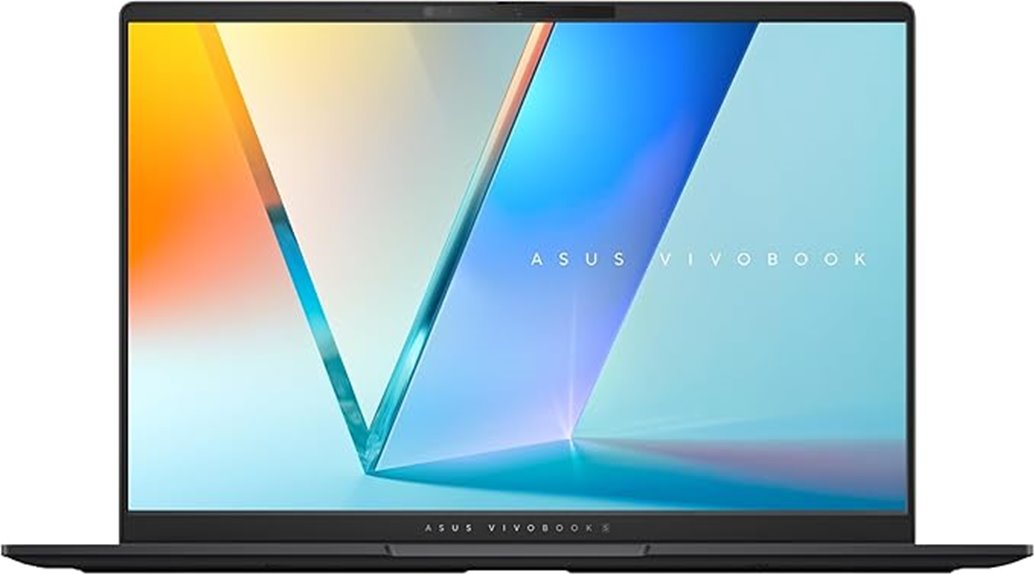Best Laptop for Architect (Top 5 Picks for 2025)
In 2025, you’ll need a laptop that combines powerful performance and stunning design for your architectural work. Look for options like the Apple MacBook Pro with the M4 chip, Acer Swift X 14, or the Apple MacBook Air 15-inch. Consider models like the ASUS Vivobook S and Samsung Galaxy Book4 Pro for their lightweight designs and impressive specs. These laptops ensure multitasking capabilities and vibrant displays. Stick around to uncover more details on features that enhance your productivity.
In the interest of full disclosure, we would like to inform you that some links on our website are affiliate links. By clicking on these links and completing a purchase from our partners, we may receive a nominal commission at no extra cost to you. Rest assured, our affiliate partnerships do not compromise the integrity of our editorial content or product evaluations. For further clarification, kindly refer to our comprehensive affiliate disclosure.
Table of Contents
What Are the Best Laptop for Architect to Buy This Year?
Here are my top picks for the best laptop for architect, you can consider this year.
Apple MacBook Pro Laptop with M4 Chip
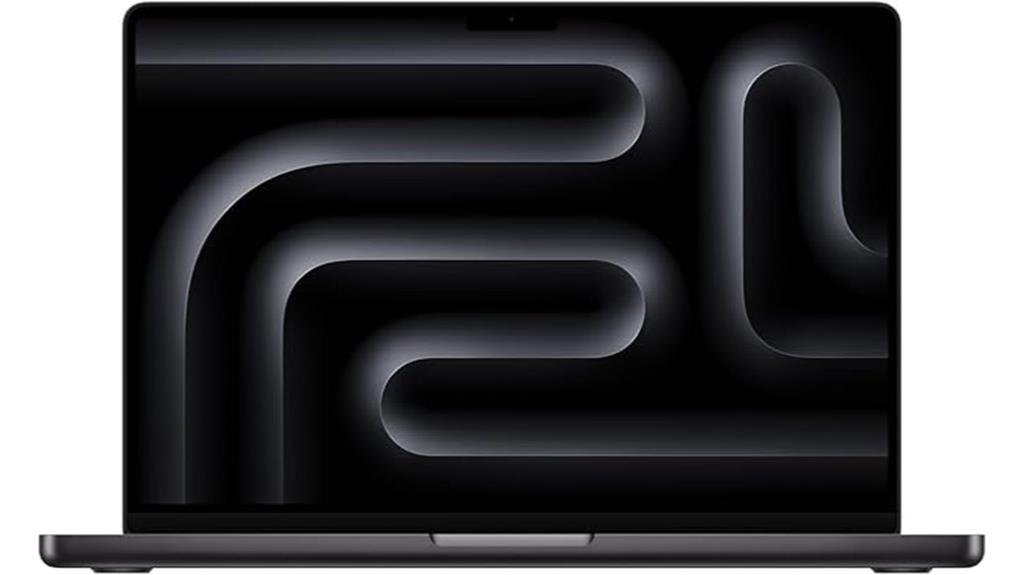
The Apple 2024 MacBook Pro with the M4 chip is an ideal choice for architects in 2025, thanks to its powerful 10-core CPU and GPU that ensure smooth performance when running demanding design software. With 16GB of unified memory and 512GB SSD storage, multitasking becomes effortless. The 14.2-inch Liquid Retina XDR display, boasting 1600 nits peak brightness and a stunning contrast ratio, delivers exceptional visuals for your intricate designs. Plus, the all-day battery life keeps you going, whether you’re in the office or on-site. Seamless integration with Apple’s ecosystem enhances your workflow, making it a top contender for architects.
Best For: Professionals such as architects and designers who need high-performance computing for demanding software and stunning visuals.
Pros:
- Exceptional performance with the M4 chip’s 10-core CPU and GPU for smooth multitasking.
- Stunning display featuring a 14.2-inch Liquid Retina XDR with high brightness and contrast for detailed visuals.
- All-day battery life ensures productivity whether plugged in or on the go.
Cons:
- Higher price point compared to other laptops in the market.
- Limited upgrade options for memory and storage after purchase.
- Compatibility issues may arise with non-Apple software or peripherals.
Acer Swift X 14 Laptop (SFX14-72G-77NJ)

Designed for architects who demand both power and portability, the Acer Swift X 14 Laptop (SFX14-72G-77NJ) stands out with its Intel Core Ultra 7 processor and NVIDIA GeForce RTX 4060 GPU. This combination ensures you can run graphically demanding software effortlessly. The stunning 14.5-inch OLED display offers a resolution of 2880 x 1800, providing vibrant visuals and TÜV Rheinland certification for eye comfort. With 16GB memory and a 1TB SSD, multitasking is a breeze. Plus, the AI features and enhanced webcam guarantee smooth collaboration. You’ll appreciate the seamless connectivity with Killer Wi-Fi 6E for all your architectural needs.
Best For: Architects and creative professionals seeking a powerful and portable laptop for demanding design tasks.
Pros:
- Exceptional performance with Intel Core Ultra 7 and NVIDIA GeForce RTX 4060, ideal for running graphically intensive applications.
- High-quality 14.5-inch OLED display with vibrant colors and TÜV Rheinland certification for reduced eye strain.
- Robust connectivity options with Killer Wi-Fi 6E and a variety of ports for seamless multitasking and collaboration.
Cons:
- The compact design may limit upgrade options for memory or storage in the future.
- Potentially high price point compared to other laptops with similar specifications.
- Battery life may be impacted when using demanding applications or AI features extensively.
Apple MacBook Air 15-inch Laptop with M4 chip
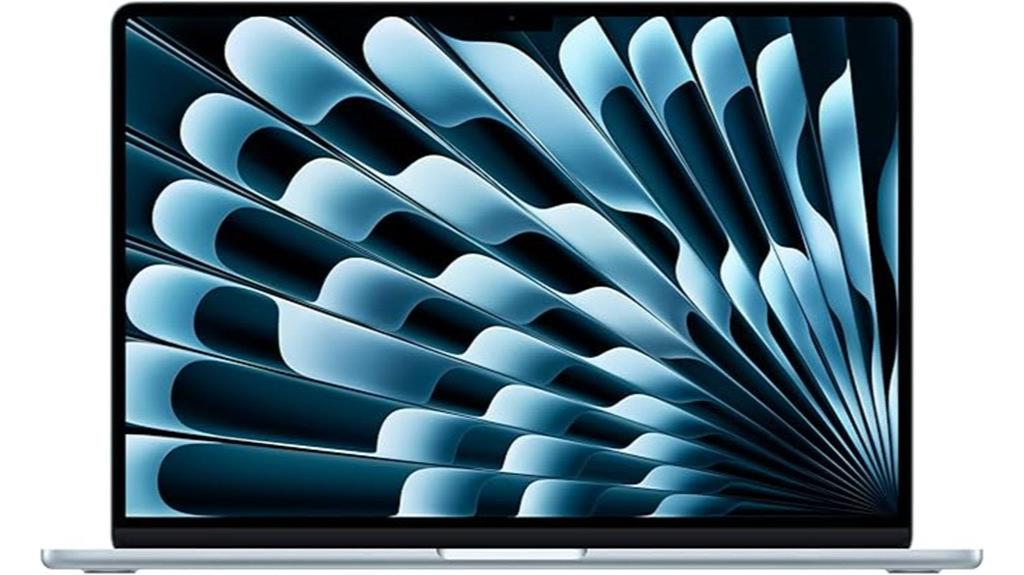
For architects seeking a powerful yet portable solution, the Apple MacBook Air 15-inch with the M4 chip stands out as an excellent choice. It delivers impressive performance, enabling you to multitask, edit videos, and even game seamlessly. With up to 18 hours of battery life, you can work all day without interruption. The stunning 15.3-inch Liquid Retina display showcases vibrant colors and sharp details, perfect for your design work. Plus, the 12MP Center Stage camera and advanced audio system elevate your virtual meetings. With ample connectivity options and robust privacy features, this laptop meets all your architectural needs efficiently.
Best For: Architects and creative professionals who need a powerful and portable laptop for multitasking and design work.
Pros:
- Impressive performance with the M4 chip, perfect for multitasking and video editing.
- Stunning 15.3-inch Liquid Retina display that supports 1 billion colors for vibrant visuals.
- Long battery life of up to 18 hours, allowing for all-day productivity without the need for frequent charging.
Cons:
- Limited upgrade options compared to traditional laptops, as components are often not user-serviceable.
- Higher price point compared to other laptops with similar specifications.
- Fewer ports compared to some competitors, which may require additional adapters for connectivity.
ASUS Vivobook S 14 OLED Slim Laptop (M5406WA-DS76)
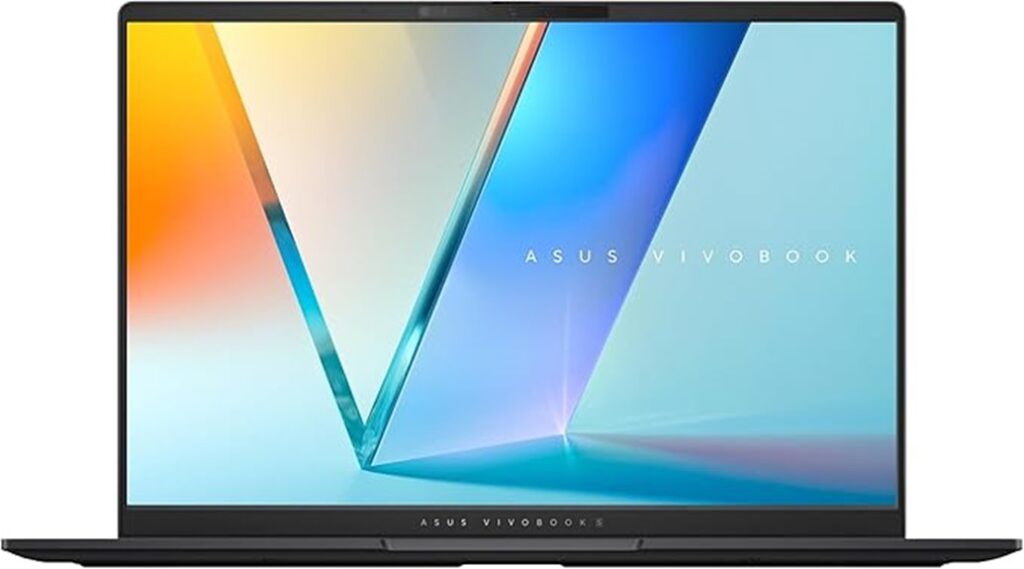
With its stunning 14” 3K OLED display and powerful AMD Ryzen 9 processor, the ASUS Vivobook S 14 OLED Slim Laptop (M5406WA-DS76) stands out as an exceptional choice for architects in 2025. This laptop boasts 24GB LPDDR5X RAM and a 512GB SSD, ensuring smooth multitasking and ample storage for your projects. The 120Hz display offers vibrant colors and a 0.2ms response time, making your designs come to life. Weighing just 2.87 lbs and measuring only 0.63” thick, it’s incredibly portable. Plus, with customizable RGB backlighting and multiple connectivity options, it’s perfect for creative professionals on the go.
Best For: The ASUS Vivobook S 14 OLED Slim Laptop (M5406WA-DS76) is best for architects and creative professionals seeking a powerful and portable device for design work in 2025.
Pros:
- Stunning 14” 3K OLED display with vibrant colors and high brightness for detailed design work.
- Lightweight and slim design makes it highly portable for on-the-go use.
- Ample RAM and SSD storage ensure smooth multitasking and efficient file management.
Cons:
- The compact size may limit upgrade options for certain components.
- High-performance specs may come at a premium price compared to other laptops.
- RGB backlighting customization may not appeal to all users.
Samsung Galaxy Book4 Pro Business Laptop (NP944XGK-KG4US)
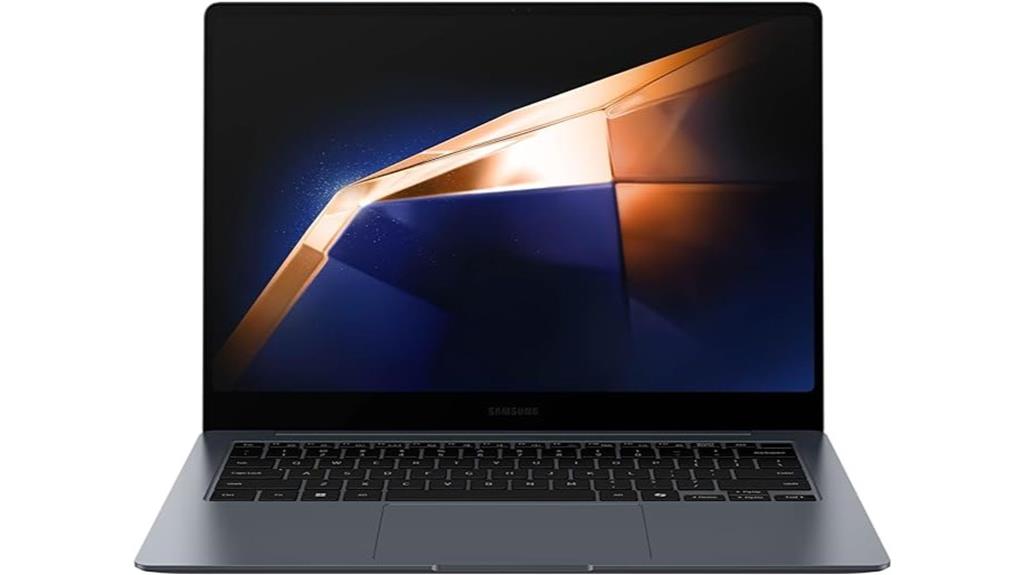
The Samsung Galaxy Book4 Pro Business Laptop (NP944XGK-KG4US) stands out as an excellent choice for architects seeking a powerful and portable device. With its Intel Core Ultra 7 processor, 32GB RAM, and 1TB SSD, you’ll handle multitasking and demanding applications with ease. The stunning 14-inch 3K AMOLED touchscreen ensures vibrant visuals, perfect for showcasing your designs. Weighing just 2.71 lbs, it’s easy to carry. You’ll appreciate the robust security features like Samsung Knox, and the seamless connectivity options, including Thunderbolt 4 and HDMI. Though the price is higher than competitors, its performance and design make it worth considering.
Best For: Professionals and architects seeking a powerful, portable laptop with a stunning display for multitasking and design work.
Pros:
- High-performance with Intel Core Ultra 7 processor and 32GB RAM, ideal for demanding applications.
- Vibrant 3K AMOLED touchscreen display enhances visual clarity for design projects.
- Lightweight and portable design makes it easy to carry for on-the-go professionals.
Cons:
- Higher price point compared to similar models from competitors.
- Limited RAM upgrade options in certain regions, capping at 16GB.
- Perceived lower quality of the OEM SSD, which may not meet expectations for the price.
READ MORE: Best Laptop for Podcast, Best Laptop for Podcasting and Video Editing, Best Laptop for Multiple Monitors, Best Laptops for Fusion 360, Best Laptop for Bloggers, Best Laptop for Animation and Graphic Design, Best Laptop for Xactimate, Best Laptop for Virtual Assistant, Best Laptop for Plc Programming, Best Laptops for Bloggers
Factors to Consider When Choosing the Best Laptop for Architect
When you’re choosing a laptop as an architect, several key factors come into play. You’ll want to consider performance and processing power, display quality, and battery life to ensure it meets your design needs. Don’t forget about portability and connectivity options, as these can greatly affect your workflow on the go.
Performance and Processing Power
Choosing a laptop for architectural work means focusing on performance and processing power to ensure efficient multitasking and smooth operation of demanding applications. Look for a multi-core processor that can handle 3D modeling and rendering software seamlessly. A dedicated graphics card is crucial, as it manages graphically intense tasks, providing smooth rendering and visualization. Make sure you have at least 16GB of RAM to avoid slowdowns when juggling large files and multiple applications. Fast SSD storage is essential for quick access to your files and faster software loading, boosting your productivity. Additionally, consider battery life; a long-lasting battery lets you work on projects without frequent interruptions, especially during site visits or client meetings.
Display Quality and Clarity
For architects, display quality and clarity play a vital role in accurately conveying designs and details. You’ll want a high-resolution display, ideally 2880 x 1800 or higher, to ensure intricate elements are clear. Look for screens with 100% DCI-P3 color gamut for true-to-life colors that accurately represent materials and finishes. Peak brightness levels of 600 nits or more will enhance visibility, especially in bright outdoor settings. A 120Hz refresh rate can provide smoother scrolling, making it easier to work with complex design software. Additionally, a larger aspect ratio like 16:10 offers extra vertical space for viewing layouts and toolbars, streamlining your workflow and improving overall efficiency in your architectural projects.
Battery Life and Efficiency
While navigating complex design tasks, having a laptop with exceptional battery life and efficiency is crucial for architects. Look for models that boast all-day battery life, ideally exceeding 10 hours, so you can work on-site without constant recharging. Efficient power management features, such as low power consumption processors, significantly extend battery life during demanding tasks like rendering or 3D modeling. High-capacity batteries (above 60Wh) are also preferable, as they provide longer usage under heavy loads typical in architectural software. Fast charging capabilities can boost productivity by allowing you to quickly recharge during short breaks. Additionally, consider energy-efficient displays, like OLED or adaptive brightness screens, to conserve battery while ensuring your designs maintain stunning visual quality.
Portability and Weight
Portability is a top priority for architects who often juggle multiple projects in various locations. You’ll want a lightweight laptop that weighs less than 3 pounds, making it easy to transport without straining your back. A slim profile, ideally between 0.5 and 0.8 inches thick, enhances mobility, allowing you to slip it into your bag effortlessly. Consider battery life too; a laptop that lasts at least 8 hours ensures you can work on-site without hunting for power outlets. A screen size between 14 and 15 inches strikes the right balance between usability and portability. Lastly, choose laptops made from lightweight materials like aluminum or carbon fiber for durability, making them perfect companions for frequent travel.
Connectivity Options Available
When choosing a laptop for architectural work, connectivity options play a crucial role in ensuring you can seamlessly integrate various tools and devices into your workflow. Look for laptops with multiple USB ports, like USB 3.2 Gen 1 Type-A and Type-C, to connect essential peripherals such as external drives and design tools. Thunderbolt 4 ports are vital for high-speed data transfer and connecting multiple displays, boosting your productivity. HDMI ports make it easy to connect to projectors and external monitors for presentations. Additionally, microSD card readers can simplify transferring large files from cameras. Don’t overlook wireless options like Wi-Fi 6E and Bluetooth 5.3, as they provide reliable connections for cloud-based applications and efficient file sharing during collaborative projects.
Software Compatibility and Support
Choosing a laptop that supports essential architectural software is crucial for your design efficiency and workflow. Make sure it runs popular applications like AutoCAD, Revit, and SketchUp, which demand robust processing power and graphics capabilities. Look for laptops with dedicated graphics cards or high-performance integrated graphics to efficiently handle 3D modeling and rendering tasks. Ample RAM, ideally at least 16GB, will facilitate multitasking and ensure smooth operation of resource-intensive applications. A high-resolution display, preferably 2880 x 1800 or higher, is essential for visualizing intricate details and colors accurately. Lastly, confirm that the laptop’s operating system is compatible with necessary software updates and plugins, as some architectural applications work best in specific OS environments.
Frequently Asked Questions
What Software Is Essential for Architects Using Laptops?
For architects using laptops, essential software includes AutoCAD for drafting, Revit for building information modeling, SketchUp for 3D modeling, and Adobe Creative Suite for presentations. You’ll need these tools to streamline your design process effectively.
How Important Is Battery Life for Architects’ Laptops?
Battery life’s crucial for your laptop as an architect. You need to work on-site or during long meetings without constantly searching for outlets. A reliable battery allows you to stay productive wherever your projects take you.
Can I Upgrade My Laptop’s Hardware Later?
Yes, you can often upgrade your laptop’s hardware later, but it depends on the model. Check if the RAM and storage are accessible, and consider your laptop’s warranty, as some upgrades might void it.
Are Touchscreen Laptops Beneficial for Architectural Work?
Touchscreen laptops can be beneficial for architectural work. They offer intuitive design, allowing you to sketch directly on the screen and manipulate models more easily. Plus, they enhance collaboration during presentations and design reviews with clients.
What Is the Average Lifespan of a Laptop for Architects?
The average lifespan of a laptop for architects is about three to five years. You’ll want to consider performance, software requirements, and design needs when choosing a model to ensure longevity and efficiency.
My Final Opinion
In conclusion, choosing the right laptop as an architect is crucial for blending performance and design. Whether you opt for the powerful Apple MacBook Pro or the sleek Acer Swift X 14, each option offers unique features tailored to your needs. Don’t forget to consider factors like processing power, display quality, and portability. With the right choice, you’ll enhance your productivity and creativity, making your architectural projects come to life seamlessly.
